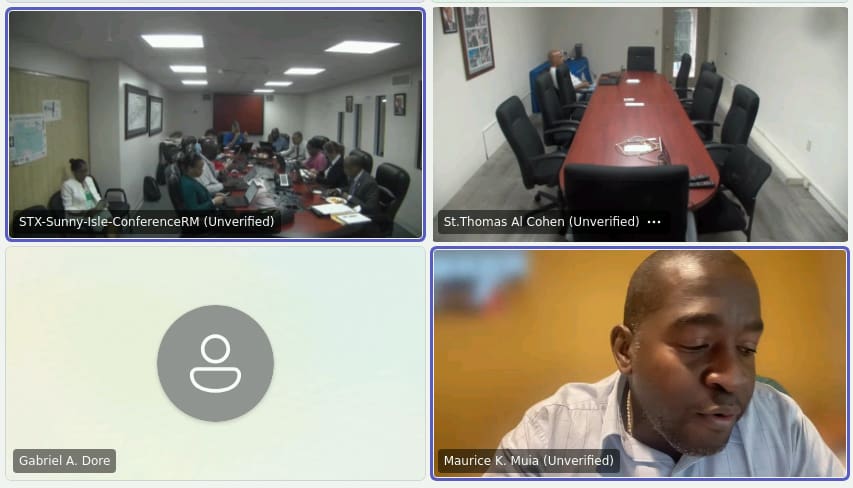
Virgin Islands Water and Power Authority Executive Director and CEO Karl Knight received the go-ahead from the utility’s governing board to negotiate an operation and maintenance contract with Wartsila and a two-year extension to the utility’s agreement with Aggreko during a regular board meeting on Thursday.
The board unanimously authorized Knight to enter negotiations with Wartsila for a three-year, $27 million contract for the operation and maintenance of four generating units at the Randolph Harley Power Plant on St. Thomas.
After discussing a personnel matter in executive session, the board authorized Knight to negotiate a two-year, $18 million extension to its agreement with Aggreko. That company shut down its generators at the Richmond Power Plant on St. Croix because of nonpayment. Gov. Albert Bryan Jr. subsequently declared a state of emergency to free up “rainy day” funds for a $2.3 million payment to the company.
Ashley Bryan, interim chief operating officer of electric, said WAPA would have the option to exit the agreement after 13 months as long as they hadn’t accrued any penalties.
“We would, however, have to pay any outstanding payables to Aggreko at the time of that termination,” she said. Later, Bryan said the utility had about $3 million in outstanding invoices.
The board breezed through the first agenda item, authorizing a two-year, no-cost extension to the utility’s contract with the National Response Corporation, or NRC. Maxwell George, WAPA’s environmental affairs manager, said the oil spill response company has worked with the utility “in excess of 23 years,” and it provides personnel, equipment, and response vessels to assist with cleanups.
Thursday’s board meeting came during a week when both districts experienced widespread outages affecting thousands of WAPA customers. The authority implemented a rotating outage schedule for St. Thomas and St. John on Thursday after Feeder 13 lost generation. In Christiansted last weekend, heavy rainfall flooded manholes and submerged underground power lines, requiring days of repairs by WAPA crews and an outside contractor.
Knight acknowledged some of the problems facing the utility’s underground infrastructure after Kyle Fleming, board member and V.I. Energy Office director, called underground projects “kind of our philosophy around the future of our system.” Fleming noted that moving power lines underground has actually made some issues harder to fix.
“We are investing a lot in undergrounding because we’re trying to mitigate against one risk, which is the high winds and wind-related damage that comes from tropical storms and events,” Knight said. “In trying to mitigate that risk, we exposed ourselves to other points of failure — in this case heavy rains and the flooding have been a challenge.”
Knight said WAPA has traditionally been an “overhead, aerial utility” and said they needed to build more in-house capacity to perform underground repairs rather than depending on contractors.
“I think if there’s a lesson that we’re learning, these are not maintenance-free systems,” he said.
During his executive director’s report, Knight said Government House cleared WAPA to pursue a $5 million disaster recovery loan to help with repairs associated with Tropical Storm Ernesto and that the utility is close to securing a municipal financial adviser. Knight also said WAPA personnel completed a review of the utility’s metering and billing system.
While he didn’t share the results of that review with the board on Thursday, Knight did say that the 1,100 new meters arrived in the territory this week. A second order of 2,500 is expected to take three months to ship to the territory.
Residents have repeatedly taken to social media or reached out to lawmakers in recent months to complain about inflated electric bills. WAPA’s troubled advanced metering infrastructure — or AMI — is slated for prudent replacement by the Federal Emergency Management Agency. In the interim, the utility has had to rely on manual meter-reading and estimation. Knight said the new meters should lead to a “modest improvement.”
“And I just need a meter-reading staff in this interim period to cover as much ground as they can, read those manual meters every month and get those accurate readings in so we can reduce the amount of estimating that we’re depending on,” he said. “So we start to make a dent in the problem come next month, then hopefully we get some momentum and progress going after that.”
At one point during Thursday’s meeting, Board Chair Hubert Turnbull asked about rumors that WAPA either has a shortage of transformers or a surplus of ones they’re unable to use. Bryan said the utility does have a surplus of 277/480-volt pole-mounted transformers that the territory received during hurricane recovery efforts.
“They’re not a common voltage class,” she said, adding that most WAPA customers use 120/240-volt transformers. “So we can’t really use the transformers. It’s not that they’re the wrong transformers, it’s just that it’s not a common voltage that we utilize in our system.”
Bryan said the transformers were purchased with FEMA funds, which makes them difficult to sell.
“Essentially, if we sell them we would have to reimburse FEMA for that as a disposal,” she said. “But either way, we reached out to some vendors to see if it’s possible to move them, and they too have stated that it’s not a marketable voltage.”
The meeting was Bryan’s last as interim COO. Knight confirmed that Bryan — who briefly led the utility last summer after the resignation of former Executive Director and CEO Andrew Smith — tendered her resignation, effective Nov. 29.
Bryan said it had been “a long 10 years, but a very, very rewarding 10 years.”
“I know WAPA gets a lot of … heat, but people will be remiss if they actually knew what you had to do to keep the lights on,” she said before thanking her colleagues.











